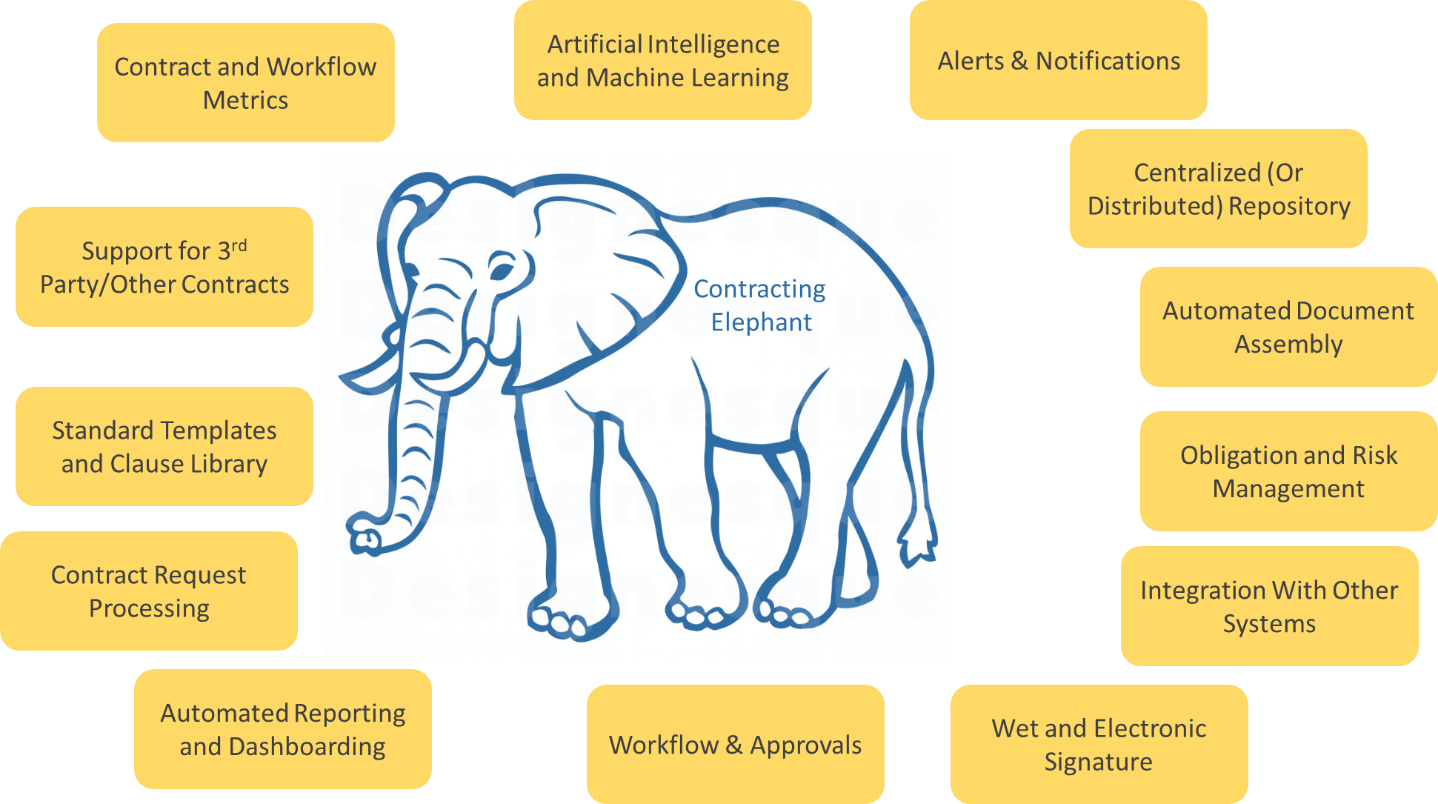What Part of the Contract Elephant Are You Talking About?
As featured in World Contracting and Commerce Association (WCC), this article examines the various components of the contract management process.
Confusion is can be addressed through metaphors and contract management is no stranger to both confusion and metaphors. It is here where we start our journey.

To be clear, this article is not about the “elephant in the room” - it’s about our definition of the elephant and how we all may view it from many vantage points.
The goal is to strengthen our understanding of our roles as contract managers and to gain a common consensus on the many parts of contract management and what matters to our organizations. In doing so, we can move to higher ground of continuously improved results.
Each person impacted by contract management will typically have a personal definition of it. We could all discuss the importance of this elephant as we collectively discover commonalities related to it. However, the reality of one’s interpretation of contract management will include both common and unique aspects that define the breadth and depth of their thinking - or, in our case, the girth and weight of the elephant.
In speaking with one organization, I discovered that some see the essence of contract management as simply a reliable and trusted repository for post execution contracts. I learned from another organization that the field is viewed as a holistic bridging of solicitations and contracts and an extensive collection of other data that requires careful management of contracts.
So, you might ask, is there a standard definition of contract management that we can uniformly agree with as there are so many aspects of contract management that mandate interpretation and wherever possible, consensus? The answer is yes, but with qualifiers.
To alleviate any confusion, certain components of contract management must be defined. Your team can then more effectively develop the appropriate level of clarity and move towards leveraging contract management tools and processes.
So, to turn your attention to the elephant, allow me to introduce our metaphorical definition. Sometimes a metaphor speaks louder than a written message. So, this elephant serves as an illustration of the many parts of the contract management process.

Definitions for both contract and noncontract professionals:
- Centralized (or Distributed) Repository: Any reliable contract management system must provide for a strong, robust and secure repository that can store all content related to contracts (the data records, the documents, obligations, etc.). An important aspect of the repository is to support complex contract relationships (e.g. how do supporting documents relate to primary contracts and what about all of the other data). For some, it is all about executed documents and for others, it is all about draft documents, I would suggest that it should be both.
- Contract Request Processing: The contract request is a simplified process allowing users to request contracts (be it a question, a highly structured form, or someplace in between). It is needed to galvanize users around the system. In short, this must be easy and anything short of that will probably not suffice. Being easy doesn’t necessarily imply less work, it implies more efficient work (which then leads to less work and rework). The applicable example is that a request typically requires a user to fill in some fields to submit the request. This provides a bit more work; however, as a result, they can accelerate the process; which is often much more efficient than sending an email to the contracts team for processing.
- Support for Third Party Contracts: Depending upon the types of contracts being processed, there is typically a need to support what is termed Third Party or Other Party paper. When the other guys give you a contract, you typically need to support the processing of it. This means loading it into the system, routing it for review and approval and making sure it is properly managed throughout the lifecycle.
- Standard Templates and Clauses Library: Most organization’s employ standard templates (and clauses) in some capacity and as part of the adoption of those templates/clauses, they must be made readily available. Standard clauses are used as primary and fallback clauses during negotiations and conform to your organization’s “playbook.”
- Automated Document Assembly: When high volume contracts are being used on your paper, automated document assembly is a natural fit for risk reduction and efficiency improvements. In short, by filling out the contract request or supporting document form, documents can be dynamically generated with contract-specific text. Be mindful that not every contract or supporting document is a good assembly candidate. When the documents are highly negotiated and rarely used, it is often better to have non-automated templates.
- Workflow and Approvals: At the heart of many contract management systems is a robust workflow and approval engine. This allows for the routing of automated approvals, notifications, escalations and visibility into any aspect of the contract management process that requires both formalized, and at times, ad-hoc reviews. However, be mindful of workflow over-automation because there is a propensity to introduce too much workflow automation at once. Workflow often mandates a smart crawl-walk-run approach.
- Alerts and Notifications: You and your user constituency will need to know about the progress of contracts and supporting data. In this regard, there is a common need to get notified on all aspects of the contract lifecycle. However, be wary of over communicating as automated alerting and notification can be too “noisy.”
- Contract and Workflow Metrics: The importance of having visibility into the progression of contract process, regardless of state, is critical. This typically requires support for contract-specific metrics as well as looking across contracts and workflow for trends and averages. These aspects of contract management will allow your organization to have a pulse.
- Wet and Electronic Signature: Without support for documents getting signed (or accepted automatically), there is no contract and no coordinated movement. Consequently, the importance of making sure the contract documents get signed becomes a big part of the contract management process -- be it electronic or wet signature. Systems and processes should be designed to easily support both wet and electronic signature and drive the behavior based upon a variety of criteria (e.g., contract type, geography or region, client preferences, etc.).
- Automated Reporting and Dashboarding: The automation of easily consumable dashboards that align with your users’ needs and personas is critical for project success. What a heads-down contract manager needs for reporting may be very different from an executive. Likewise, business users need to see information that pertains only to them. Consequently, the need to dynamically and systematically generate reports and produce intuitive dashboards becomes a key part of contract management.
- Obligation and Risk Management: For simpler and typically higher volume contracts, Obligation and Risk Management often play a minor role in contracting initiatives. For complex and lengthy contracts, managing contract obligations is vital to an organization’s success. This is typical of more sophisticated contracts where specific obligations are called out and executed upon in a systematic fashion. This introduces efficiencies and de-risks the contract.
- Integration With Other Systems: Line of Business Integration with ERP systems, CRM systems, industry specific systems and add-on tools take some serious work both from a technical as well as logistics, testing and business perspective. However, once completed and in a steady state, the benefits of such integrations are very powerful, because they lead to eliminating redundant data entry, to gaining visibility into other systems, to becoming more efficient.
- Artificial Intelligence and Machine Learning: In the world of contract management, this type of brain power must be harnessed to automatically extract metadata from contracts and supporting documents, to compare clauses between 3rd parties and your standard language, and as appropriate, to perform analytics on the contract information. At this point, Artificial Intelligence (AI) and Machine Learning (ML) applications are playing a more important role for contract management and in general across many other types of business functions. However, do not underestimate the need to train the AI/ML components of contract management if you want to get the most out of them.
- Peripheral and Related Contract Applications - While elephants need no supplements to exist, for human interaction, there is often a need to have some supplemental components that allow for the elephant to harmoniously coexist. For example, the “Howdah” is the elephant saddle that people ride in. In a somewhat similar fashion, contracts do not operate in isolation. It is critical to link other information to contracts. For example, some companies want to track invoices, orders or spend data. Medical care providers want to track CPT codes and fee schedules that relate to contracts. For others, legal operations are key as are compliance processes and artifacts. Often, the contract can serve as the hub for related information.
- Training the right way for the right people and for the right amount of time: While a good portion of this article is focused on capabilities often associated with a contract management “system,” I would be remiss if I did not emphasize the importance of investing in the initial and ongoing training of the user constituency. The reality is that contract management systems represent change and many people are uncomfortable with the disruption associated with such change. With proper planning, training, and much communication, the elephant can be correctly tamed and very productive.
Without proper considerations, contract management stakeholders will behave like the blind men from the elephant parable. They will maintain only their perspective of contract management and miss out on the larger purpose and reality. As you speak with your colleagues about the various aspects of your contract management requirements, use these categories to better establish a common understanding of contract management components and you’ll soon have an improved definition of what contract management means to you, your business and your user constituency (internal and external).
END NOTE - REFERENCE:
1. Article: White Papers by SFG.
Assessments managed by THE SANTA FE
ABOUT THE AUTHOR
Russ Edelman is the Founder and CEO of Contracts 365, Inc., the leading provider of contract management software for businesses that run on Microsoft 365. With clients such as Intel, Hyundai, Logitech, Urban Outfitters, LPGA and other blue-chip organizations, Contracts 365 remains at the forefront of this industry, both in terms of world class technical solutions as well as on-going thought leadership. Russ is an AIIM fellow and serves as an active industry analyst helping to define key industry trends by contributing to media outlets including HBR, InformationWeek, CIO Magazine, AIIM Communities and KMWorld.

Russ co-authored his first book titled “Nice Guys Can Get The Corner Office”, published by the Penguin Group. The book has a rich set of data points from hundreds of surveys and includes relevant commentary from CEOs of major companies who were interviewed for the book. CEOs from Southwest Airlines, PwC, The Outback and many others weighed in on the subject. It has received international praise and he has been featured on TV, radio, magazine and podcast interviews. Russ blogs on CNBC and Huffington-Post as he reports on relevant management trends.